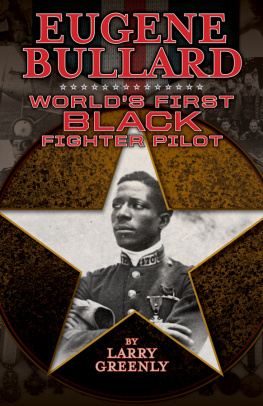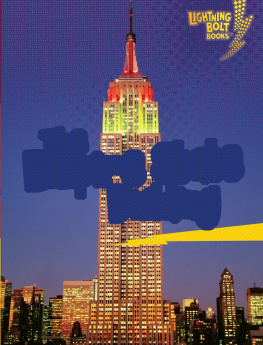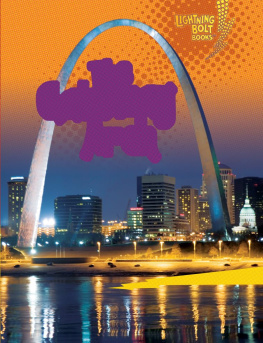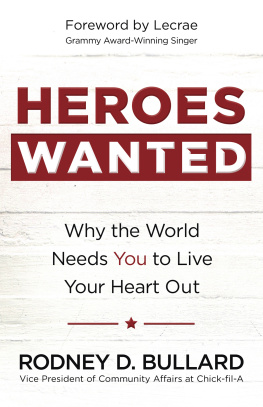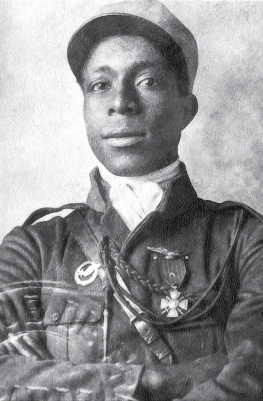For Edith, my wife of many years, who made this book (and many other things in my life) possible
Several years ago, I wanted to write a biography of someone who had ties to the Southwest. While actively searching for someone interesting, I happened to watch the movie Flyboys (2006). Even though Flyboys was an exciting film to watch, it had a number of historical and technical inaccuracies, particularly the conflating of the Lafayette Escadrille with the Lafayette Flying Corps. Confusion still exists between those two units with similar names, but more about that later.
I first zeroed in on one of the pilots, Blaine Rawlings, who was from Texas (at least in the film). Rawlingss character was based on the real-life World War I ace, Frank Luke, who was born in Arizona. Then I noticed the black character, Eugene Skinner, who was a boxer before he became a pilot for France. Skinner was loosely based on Eugene Bullard from Georgia, who is the subject of this book.
When I did a little research on Eugene Bullard, I found that he was a particularly interesting person but not very well known. A search of Albuquerques library system using Bullards name turned up a rare copy of The Black Swallow of Death by P. J. Carisella and James W. Ryan. The book consisted of Bullards memoirs, which he wrote in the latter years of his life, as well as interviews of Bullards associates by Carisella and Ryan.
The Black Swallow of Death literally changed my life. After reading it, I couldnt forget the outrageously colorful life that Bullard had led. Here was a story that deserved to be told, a story of a courageous black man who grew up poor in America and later became a highly decorated World War I soldier and pilot in France. Yet when he returned to the United States, he suffered prejudices until he died in relative obscurity. I researched Bullard further and obtained much of my information from the books listed in Further Reading, particularly The Black Swallow of Death ; Eugene Bullard: Expatriate in Jazz-Age Paris ; and The Lafayette Flying Corps, Vols. 1 and 2.
This book is a narrative biography: factssuch as people, dates, places, and activitiesare as accurate as possible, but the dialogue is mostly fabricated. A narrative biography strives to turn a mundane compilation of facts into an exciting book for readers to enjoy. There is no doubt that Bullard misremembered some of his exploits or even exaggerated them in his memoirs, but I chose the facts the best I could from among various sources. On occasion, I may have used an exaggeration from Bullard himself, but I was always cautious to make sure the essence of his story remained true.
As mentioned above, many contemporary readers are confused by the similar names of the Lafayette Escadrille and the Lafayette Flying Corps. Such confusion is no doubt compounded by the Flyboys movie and other sources. The difference between the two units are:
The French Service Aronautique was the overall French Air Force. The Escadrille Amricaine, a subordinate component of the Service Aronautique, was formed to allow American pilots to fly and fight for France. The Franco-American Corps, also a subordinate component of the French Service Aronautique, was formed to allow both French and American pilots to fly together.
Germany complained to France that the United States was neutral at that time and that Americans flying against Germany was a diplomatic violation. As a consequence, France removed the reference to Americans flying for France by renaming the Escadrille Amricaine to the Escadrille Lafayette. Soon after, France renamed the Franco-American Corps to the Lafayette Flying Corps for the same reason.
Eugene Bullard flew for the Lafayette Flying Corps, not the Lafayette Escadrille. He was a truly remarkable man. I hope this book will inspire others to celebrate his life and remember him as an American hero.
First and foremost, Id like to thank my critique group, Rob Spiegel, Sue Houser, Wendy Bickel, and Jacqueline Bickel, for their endless encouragement and their tireless support in making my manuscript the best it could be.
Id be remiss in not mentioning SouthWest Writers, one of the most supportive writing organizations in the country. As a long-time member, I have learned about writing over the years from some of the best writers in the country.
I found Brett Stolle in the United States Air Force National Museum, Research Division, to be a lifesaver when I desperately needed high-resolution images of Eugene Bullard. I also owe Kathy Kitts a debt of gratitude for the French pronunciation guide included in this book.
And I can never repay those other writers who believed in this book enough to write cover blurbsespecially my friend, David Morrell.
Sources of Illustrations
Pages 2, 29, 37, 40, 59, 63, 76, 79, 82, 83, 88, 89, 112, 132, 133, 137: courtesy of the National Museum of the U.S. Air Force in Dayton, Ohio.
Pages 65, 71, 73, 85: from The Lafayette Flying Corps by Charles Nordhoff (now in the public domain).
Page 98: from http://www.airwar.ru/enc/fww1/pfd3.html (public domain).
Page 134: the photo was taken at the National Museum of the U.S. Air Force by, and is used courtesy of, Flickr user OZinOH.
Lucky
Eugene Bullard struggled to keep his sputtering biplane from crashing. He headed back toward French-occupied territory. Tracer bullets from machine guns in the trenches below streaked around him. Thwack, thwack, thwack! A line of holes marched across a lower wing.
Splang! One bullet punched through the front cowling. The SPADs engine belched black smoke. Sweet-smelling castor oil sprayed Bullards windshield and face. He wiped his goggles with his sleeve and desperately worked his throttle to keep the engine running.
It seemed like every German soldier in the trenches below was firing at him while Bullard coaxed his puttering plane over the enemy lines. The SPADs engine gasped one last time and died. Bullard had no choice now. He had to landin a plane that glided like a brick.
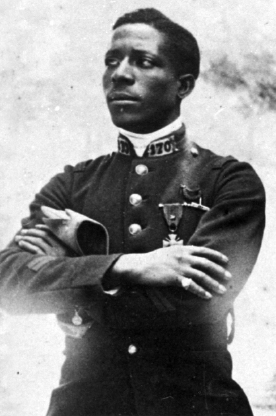
Eugene Bullard, shown here in his French aviators uniform, was a member of the French Foreign Legion and flew with the French Lafayette Corps.
A muddy field in no-mans land appeared ahead. Wind whistled past Bullards falling plane. Pushing away fear, he focused on landing. He tore off his goggles; they might shatter on impact. The ground came up fast. Bullard held his breath. Dont stall, keep the wings level, dont hit a shellhole . He carefully pulled back on his stick. The SPADs wheels hit ground. The plane bounced, bounced, bounced and finally came to rest.
Bullard exhaled. At least I didnt flip over. Machine-gun bullets drilled the air around the downed SPAD. Bullard unfastened his seat belt, clambered over the far side of his fuselage, and fell into a muddy crater. As long as the Germans were firing at him, he could only lie in the cold mud and listen to bullets puncturing his plane.

